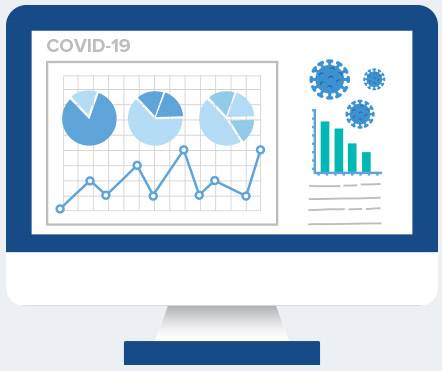You put in the daily work to make sure your practice is successful and thriving, treating and solving your patients’ medical problems – which is no easy feat in the best of times. During our current pandemic, you may see fewer patients and experience more downtime than before, with a significant portion of staff working from home. It throws into focus how effective practice management is based not only on patient care but a wide range of dynamic functions. If your practice isn’t functioning efficiently, anywhere will it become more apparent than your revenue cycle?
Revenue cycle management (RCM) is a deceptively simple name for a challenge every practice faces. Encompassing the entire revenue cycle from start to finish, effective RCM at its best yields efficiency and provides awareness through your practice’s key performance indicators (KPIs). Responsibly analyzing your RCM processes and KPIs both as a whole and by each of their parts prevents RCM at its worst: aging AR, inaccurate reimbursements and lingering bad debt.
Although the value of effective RCM is undeniable, the most common obstacle practices face is time. But now you have an unprecedented opportunity to set your practice up for RCM success. In the face of the global pandemic, your remote staff have time available to take on such an in-depth, collaborative task. And the more in-depth your RCM documentation becomes – as tedious as it can be – the more your practice will progress from just surviving to really thriving.
Map out your RCM processes
Make it quick and painless by starting simply. Your RCM map may look something like this:
Front End Operations
- Appointment Scheduling
- Eligibility Verification
- Authorizations
- Collections at Time of Service (TOS)
- Encounter Reconciliation
Back End Operations
- Coding
- Charge entry
- Claim Submission
- AR Followup / Denial Management
- Patient Collections
Once you’ve mapped your revenue cycle, the next goal is to document your processes for each of the listed steps. Chances are you’re already somewhat aware of the weak points within your revenue cycle, so this is the perfect time to hone in with actionable changes that will help operations go more smoothly and produce better results.
Appointment Scheduling
Missed appointments equal missed revenue, so effective patient scheduling and appointment reminders are paramount. Front office staff should be made aware of the minimum amount of information needed at scheduling, and these details should be documented in the RCM process.
Eligibility Verification
Most modern medical software now offers eligibility verification as an automated service, confirming a policy is active at the click of a button and freeing up staff to handle benefits verification. Benefits verification goes a step further than eligibility by confirming the patient is covered for the specific service the provider needs to render. Staff should be taught the difference between eligibility and benefits verification, and it should be documented how to best conduct each.
Authorizations
Authorizations are notorious for giving the impression of coverage before services are rendered, then citing the services as non-payable afterwards, so if there are any reasons to doubt a patient’s coverage, always double-check. Compile a list of payers that typically require authorizations and when they require them, then document the process your practice must go through to obtain these authorizations.
Collections at TOS
The best time to collect from a patient is at the time of service. The evolving nature of the insurance market means patients are starting to learn and understand their financial responsibility for medical care. If a patient is experiencing hardship, flexible options like payment plans offer patients and your practice the opportunity to work together to meet their needs in a way that’s beneficial for everyone. Consider leveraging patient experience platforms like Breeze by CareCloud which offer payment plan options as well as the ability for patients to pay at the point of service.
Encounter Reconciliation
Encounters that are open/saved and remain unposted negatively impact your billing lag KPI. This triggers a domino effect towards other KPIs like charge lag and payment lag, dragging down your efficiency levels and slowing payments. Document who should be monitoring encounter reconciliation as well as when and how they should take needed actions.
Coding
Accurate coding is the backbone of successfully paid claims. Coding to the highest level of specificity is what payers look for when they receive claims – codes that are too vague or don’t match the procedure they’re assigned to will result in denials and delayed payments. Document who is responsible for coding and their exact coding workflow.
Charge Entry
As a partner task to coding, charge entry is critical. When the provider signs on off an encounter, the charge should be entered as soon as possible. If you’re behind on charge entry, getting caught up will significantly improve your KPIs. Document the charge entry process for your RCM including benchmarks for turnaround time and action steps for improving completion rates.
Claims Submission
Proper claims submission is how your practice gets paid. Who is responsible for scrubbing? Who reviews the final, scrubbed claims before submission? Who submits the batch, and if the clearinghouse rejects the batch for claims errors, who researches, corrects and resubmits the claims for processing? These answers and detailed instructions should be documented.
AR Followup / Denial Management
After claims are received by the payers, regular follow up is required for denied, unpaid, or unprocessed claims. Denials need to be researched by payer so their validity can be determined for each claim. Document these operating procedures and include who is responsible for the task, the exact AR reports that should be run, how to work from each report, and how often AR and denials should be managed.
Patient Collections
Even a seasoned professional may cringe at the word ‘collections,’ but it’s a critical part of healthy RCM and doesn’t have to be painful. Patients simply need to be made aware of their financial responsibility for seeking treatment. Document the staff roles responsible for collecting patient payments, procedures for patient contact about outstanding balances, and each step of the patient collections process.
Measure Your Results with Reports and Key Performance Indicators (KPIs)
Once your steps are documented and you’ve begun making your improvements, measure your results. This is how to track all the positive changes you’ve made. Be sure the reports and KPIs you refer to are tailored to the goals and needs of your practice. Frequently needed reports and most impactful KPIs may look like this:
Reports
- Monthly reports
- Weekly reports
- New reports for remote workers
KPIs
- Charge lag
- Payment lag
- A/R > 120
- Days in A/R
- Reimbursement Rates
- Average Reimbursement per Encounter
- First Pass Denial Rate
- First Pass Resolution Rate
You may already be generating reports like the ones available in CareCloud Advanced Analytics to track the productivity of your remote staff. In addition to those, assess every type of report the practice needs to run on a daily, weekly, monthly, and long-term basis. Document when each report should be run, the filters that should be applied, to whom it should be distributed, and finally the reason why it’s been run. Evaluate the information in the reports and, if needed, experiment with parameter and filter adjustments to optimize your practice’s reporting to utilize the KPIs that provide the most value.
Share the final results
Finally, don’t forget to share the RCM documentation results with your team. Successfully meeting a challenge like this will take collaboration from everyone on your staff, and it’s key to share the reward of implementing these positive changes. Visible outcomes show everyone the progress they’ve made together, providing a great team-building experience and boost to morale at a time when everyone could use a little good news.




